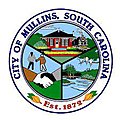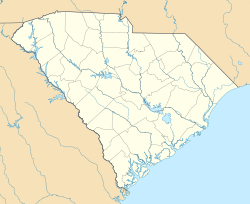Mullins, South Carolina | |
|---|---|
 Downtown Mullins | |
| Nickname: "The City of Opportunity" | |
| Coordinates: 34°12′09″N79°15′03″W / 34.20250°N 79.25083°W [1] | |
| Country | United States |
| State | South Carolina |
| County | Marion |
| Area | |
• Total | 3.02 sq mi (7.82 km2) |
| • Land | 3.02 sq mi (7.82 km2) |
| • Water | 0 sq mi (0.00 km2) |
| Elevation | 98 ft (30 m) |
| Population | |
• Total | 4,026 |
| • Density | 1,332.6/sq mi (514.52/km2) |
| Time zone | UTC-5 (EST) |
| • Summer (DST) | UTC-4 (EDT) |
| ZIP code | 29574 |
| Area codes | 843, 854 |
| FIPS code | 45-48805 [4] |
| GNIS feature ID | 2404338 [1] |
| Website | mullinssc.us |
Mullins is a city in Marion County, South Carolina, United States. As of the 2010 census, the city population was 4,663.
Contents
- History
- Geography
- Demographics
- 2020 Census
- 2000 Census
- Government
- Education
- Notable people
- References
- External links
Incorporated on March 4, 1872, Mullins was named after Col. William S. Mullins, who served as a representative for Marion County in the South Carolina State Legislature from 1852 to 1866.


